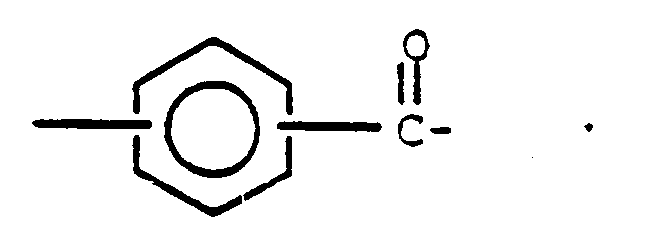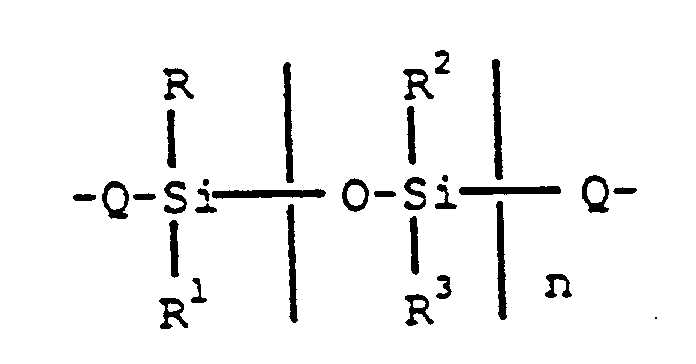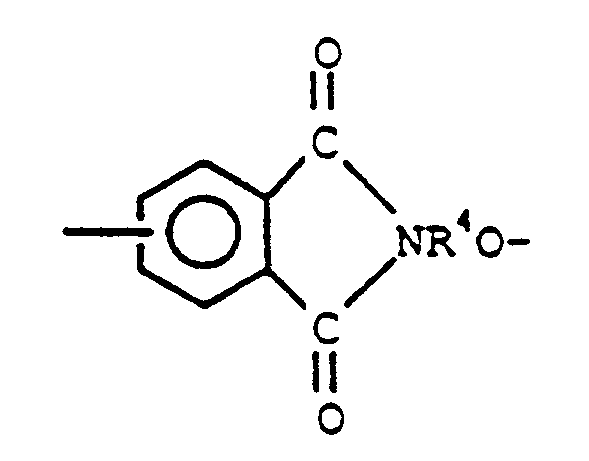|
(11) | EP 0 386 549 B1 |
| (12) | EUROPEAN PATENT SPECIFICATION |
|
|
| (54) |
Aromatic polyester-siloxane block copolymers and method for making Aromatische Polyester-Siloxan-Blockcopolymere und Verfahren zu deren Herstellung Copolymères séquencés polyester-siloxane aromatiques et procédé de leur préparation |
|
|
|||||||||||||||||||||||||||||||
| Note: Within nine months from the publication of the mention of the grant of the European patent, any person may give notice to the European Patent Office of opposition to the European patent granted. Notice of opposition shall be filed in a written reasoned statement. It shall not be deemed to have been filed until the opposition fee has been paid. (Art. 99(1) European Patent Convention). |
Background of the Invention
[0001] The present invention relates to aromatic polyesters having chemically combined siloxane units and method for making such materials. More particularly, the present invention relates to the employment of certain arylsilicone-containing materials, such as bis(acylchlorophenyl)-tetramethylsiloxane and derivatives thereof and mixtures of such arylsilicon diacids with aromatic organic diacids, such as terephthaloyl and isophthaloyl acids or derivatives with dihydric phenols to produce polyester-siloxane block copolymers.
[0002] Prior to the present invention, p,p and m,m(1,1,3,3-tetramethyl-1,3-disiloxanediyl)bisbenzoic acid and the corresponding diacid chloride was reported by D.W. Lewis and G.C. Gainer, Journal of the American Chemical Society, 74, 2931 (1952). There is also reported by J.C. Bonnet and E. Marechal, Bull. Soc. Chim. Fr.,9,3561 (1972) that the aforementioned tetramethyldisiloxane bisbenzoic acid or derivative was reacted with ethylene glycol to give a polyester-disiloxane.
[0003] The present invention is based on the discovery that aromatic polyester-siloxane block copolymers can be made by effecting reaction between dihydric phenols such as bisphenol A with tetraorganodisiloxanebisbenzoic acid, or the corresponding acid halide thereof having the formula,
or mixtures thereof, with aromatic diacids, such as terephthalic acid, or isophthalic or the corresponding acid halides where R-R³ of formula (1) are selected from the same or different C(1-13) monovalent hydrocarbon radicals substituted with radicals inert during condensation reactions, and X is selected from hydroxy and chloro. Additional aromatic polyester-siloxane block copolymers can be made by employing the aforementioned aromatic diacids, or mixtures thereof with the bisbenzoic acid tetraorganosiloxane of formula (1), with tetraorganosiloxanebis (imidephenol)s of the formula
or mixtures thereof with dihydric phenols, where R-R³ of formulas (1) and (2) and X are as previously defined, and R⁴ is a C(6-13) divalent aromatic organic radical.
Statement of the Invention
[0004] There is provided by the present invention aromatic polyester-siloxane block copolymers comprising chemically combined aromatic polyester units, containing units derived from dihydric phenols and aromatic diacids and condensed siloxane units in a molar ratio of 0.1 to 100 moles of the siloxane units to 100 moles of the condensed polyester units, where the condensed siloxane units have the formula,
wherein Q is a member selected from
R-R⁴ are as previously defined, and n is an integer having a value of from 1 to 200 inclusive.
[0005] Radicals included within R-R³ are more particularly C(1-8) alkyl radicals such as methyl, ethyl, propyl, butyl, pentyl and hexyl; substituted alkyl radicals such as trifluoropropyl, cyanoethyl and cyanopropyl; alkenyl radicals, for example, vinyl, propenyl, aralkyl radicals, such as benzyl and phenylethyl; aromatic radicals, for example, phenyl, tolyl, xylyl, anthryl and naphthyl; nitrophenyl, cyanophenyl and chlorophenyl. Radicals included within R⁴ are, for example, phenylene, tolylene, naphthylene, etc.
[0006] Among the aromatic diacids and acid halides which can be employed in the practice of the present invention, there are included, for example, dicarboxylic acids, such as terephthalic acid and isophthalic acid and esters thereof, and dicarboxylic acid chlorides such as
X is O, S, SO²,
C(R5)₂, and R⁵ is H, C(1-8) alkyl, or CF₃.
[0007] Some of the dihydric phenols which can be used to make the aromatic polyester-siloxanes useful in the practice of the present invention for making poly(arylene silicon) material having chemically combined units of formula (2) are included within the formula
HOR⁶OH (8)
where R⁶ is a C(6-13) divalent aromatic hydrocarbon radical. Dihydric phenols included within formula (8) are, for example, 2,2-bis-(2-hydroxyphenyl) propane, 2,4'-dihydroxybiphenylmethane, bis-(hydroxyphenyl) methane, 2,2-bis-(4-hydroxyphenyl) propane, referred to hereinafter as "bisphenol A" or 'BPA', 1,1-bis(4-hydroxyphenyl)ethane, 1,1-bis(4-hydroxyphenyl)propane, 4,4'-dihydroxybiphenyl, 4,4'-dihydroxy-3,3',5,5'-tetramethylbiphenyl, 2,4-dihydroxybenzophenone, 4,4'-dihydroxydiphenylsulfone, 2,4-dihydroxydiphenylsulfone, 4,4-dihydroxydiphenylsulfoxide and 4,4'-dihydroxydiphenyl-sulfide, tetramethyl bisphenol,1,1-dichloro-2,2-bis(4-hydroxyphenyl)ethylene, 6,6'-dihydroxy-3,3,3',3'-tetramethyl-bis-1, 1'-spiroindane,
In a further aspect of the present invention, there is provided a method for making aromatic polyester-siloxane block copolymers of the present invention having chemically combined siloxane units of formula (3) by effecting reaction between a tetraorganosiloxane bisbenzoic acid or derivative of formula (1) or a tetraorganodisiloxane bisimide arylhydroxy compound of formula (2), or mixture thereof with sufficient aromatic diacid and/or aromatic dihydric phenol as previously defined to produce an aromatic polyester-siloxane block copolymer comprising chemically combined aromatic polyester units and 0.1 to 100 mole percent of siloxane units of the formula
and thereafter equilibrating the resulting aromatic polyester-siloxane block copolymer with organocyclopolysiloxane of the formula
to produce aromatic polyester-arylsiliconsiloxane block copolymers having chemically combined siloxane units as shown by formula (3), where R-R³ are as previously defined and m is an integer equal to from 3 to 8 inclusive.
[0008] In the practice of the invention, the aromatic polyester-siloxane block copolymers can be prepared by solution, interfacial or melt polymerization. Temperatures in the range of from about 25° to 300°C can be used in instances where solution polymerization is employed. An inert organic solvent such as chloroform, o-terphenyl or ditolyl sulfone can be used.
[0009] Melt polymerization is preferred and can be utilized at temperatures in the range of from 50°C to 400°C . The diphenyl ester or dimethyl ester of the tetraorgano bis-benzoic acid of formula (1) can be used with an appropriate dihydric phenol under vacuum to remove the alcohol condensation by-product.
[0010] The aromatic polyester-siloxane block copolymers of the present invention can be used in a variety of applications as molding compounds, extruded films, adhesives, coatings, composite matrix material, and as modifying agents when blended with other thermoplastic materials. The aromatic polyester-siloxane block copolymers of the present invention also can be engineered to rigid-high modulus materials for use as structural plastics having desirable thermostability and resistance to combustion. In instances where the copolymers have silicone blocks of at least 2 chemically combined units, they are found to be ductile while still possessing high thermal stability.
[0011] The aromatic polyester-siloxane block copolymers of the present invention can be blended with fillers such as silica filler, glass fibers, carbon fibers, provide for a blend having from 1 to 100 parts of filler by weight per 100 parts of copolymer.
[0012] In order that those skilled in the art will be better able to practice the present invention, the following examples are given by way of illustration and not be way of limitation. All parts are by weight.
Example 1
[0013] A mixture of .01 mole of bisphenol A, or an equimolar mixture of bisphenol A and biphenol was added to 60 ml. of a .3312 mole standardized sodium hydroxide solution and 60 ml. of distilled water and the resulting mixture was stirred on low speed for 1 to 2 minutes. There was then added, 0.6 grams of sodium dodecylsulfate dissolved in 6 ml. of distilled water. To the resulting mixture there was added, .01 mole of 1,3-bis(3-benzoylchloro)-tetramethyldisiloxane or a combination thereof with isophthaloyl chloride and terephthaloyl chloride dissolved in 60 ml. of chloroform. The resulting mixture was stirred in a blender to a higher speed for 15 to 20 minutes and at a lower speed for another 5 minutes. Another mixture was prepared following the same procedure using .01 mole of 4,4′-dihydroxydiphenylsulfone and .01 mole of the aforementioned bisbenzoylchlorotetramethyldisiloxane. The various condensation mixtures were then respectively poured into a liter of acetone to effect the coagulation of product. The resulting product was filtered, transferred back to the blender which contained distilled water and blended at low speed for 5 to 10 minutes. The product was washed with water for a total of 3 times and filtered each time to ensure removal of any salt. The product was then transferred to a vacuum oven at 60°C for 12 hours. Based on method of preparation, the product was an aromatic polyester siloxane block copolymer consisting of chemically combined aromatic dihydric phenol units and siloxane diacid units, and aromatic diacid units as shown by the following table, where "DACS" is (1,1,3,3-tetramethyl-1,3-disiloxanediyl)bisbenzoic acid chloride, "BPA" is bisphenol A, "BP" is dihydroxybiphenyl, and "DHS" is 4,4′-dihdydroxydiphenylsulfone) "TC' is terephthaloyl chloride and "IC" is isophthaloyl chloride:
[0014] The above results show that interfacial polymerization is a satisfactory procedure for preparing a variety of the aromatic polyester-siloxane block copolymers.
Example 2
[0015] In accordance with the procedure of example 1, 1.5g of an aromatic polyester siloxane was prepared by reacting isophthaloylchloride/terephthaloyl chloride/DACS/BPA in the molar ratio of 3.5:3.5:3:10 dissolved in 5 ml chloroform. To the solution was added 50 microliters of methanesulfonic acid and 0.6g octamethylcyclotetrasiloxane. The mixture was heated to 50°C for 24 hours, cooled and 0.2 g of magnesium oxide powder was added. The mixture was stirred for 30 minutes and filtered. The polymeric product was isolated by precipitation of the chloroform solution into methanol and was dried in vacuo overnight to yield 2.0g of a white solid. The polymer was analyzed by GPC and found to have an Mn of 17,000 and an Mw of 47,000. The polymer had an intrinsic viscosity in chloroform of 0.7 dl/g and was found to contain silicone blocks consisting of 6.7 dimethylsiloxy repeating units by silicon NMR. The polymer was found to have a Tg of 178°C by differential scanning calorimetry.
Example 3
[0016] A solution of 34.24 of bisphenol A, 823 ml. of 10.3646 M sodium hydroxide and 105 ml. of triethylamine was stirred for 5 minutes under nitrogen atmosphere. There was then added to the solution, 10.15 g. of terephthaloyl chloride, 10.15 g. of isophthaloyl chloride and 20.57 g. of 1,2-bis(4-benzoylchloro)-1,1,2,2-tetramethyldisiloxane dissolved in 400 ml. of methylene chloride. The contents were stirred vigorously for 4 hours, extracted twice with dilute HCl, five times with deionized water, dried over MgSO₄, filtered, precipitated into methanol and dried at 90°C for 24 hours under vacuum. There was obtained an aromatic polyester-siloxane copolymer having an Mn of 35,900, a Mw of 108,100, a MWD of 3.01 and Tg of 145°C. The siloxane polyester copolymer was melt blended in an extruder with Lexan® polycarbonate 140 powder, a product of the General Electric Company, at a weight ratio of 5:95 of siloxane polyester to polycarbonate The blend was injection molded into 3.175mm (1/8") flame bars and tested for flammability by the standard UL94 procedure. The blend was found to be V-O by the UL94 test compared to the polycarbonate control which failed the test due to its propensity to burn and drip once ignited. The oxygen index of the siloxane polyester polycarbonate blend was 37% at 3.175mm (1/8") as compared to a polycarbonate control of 28%.
[0017] Although the above examples are directed to only a few of the very many variables which can be used in the practice of the present invention to make the aromatic polyestersiloxane block copolymers, it should be understood that the present invention is directed to the use of a much broader variety of dihydric phenols, aromatic diacids, organic solvents and polyorganosiloxane bisbenzoic acids or organodisiloxane imide aromatic hydroxy compounds shown by formulas (1) and (2) as described in the description preceding these examples.
1. An aromatic polyester-siloxane block copolymer comprising chemically combined aromatic
polyester units containing units derived from dihydric phenols and aromatic diacids
and condensed siloxane units in a molar ratio of 0.1 to 100 moles of the siloxane
units to 100 moles of the condensed polyester units, where the condensed siloxane
units have the formula,

wherein Q is a member selected from

R-R³ are selected from C(1-13) monovalent hydrocarbon radicals, and C(1-13) monovalent hydrocarbon radicals substituted with radicals inert during condensation reactions, R⁴ is a C(6-13) divalent aromatic organic radical and n is an integer having a value of from 1 to 200 inclusive.
wherein Q is a member selected from
R-R³ are selected from C(1-13) monovalent hydrocarbon radicals, and C(1-13) monovalent hydrocarbon radicals substituted with radicals inert during condensation reactions, R⁴ is a C(6-13) divalent aromatic organic radical and n is an integer having a value of from 1 to 200 inclusive.
2. An aromatic polyester-siloxane block copolymer of claim 1 ,where Q is

and R⁴is as defined in claim 1.
and R⁴is as defined in claim 1.
3. An aromatic polyester-siloxane block copolymer of claim 1, where Q is

4. An aromatic polyester-siloxane block copolymer of claim 1 where the aromatic polyester
units are formed by condensing bisphenol A and terephthaloyl chloride, or a mixture
of terephthaloyl and isophthaloyl chloride.
5. An aromatic polyester siloxane block copolymer of claim 1 where the aromatic polyester
is made by using dihydroxybiphenyl.
6. An aromatic-siloxane block copolymer in accordance with claim 1, where R⁴ is phenylene.
7. An aromatic polyester-siloxane block copolymer of claim 1 where the dihydric phenol
unit is a bisphenol A unit.
8. An aromatic polyester-siloxane block copolymer of claim 1 where the dihydric phenol
unit is a tetramethyl biphenol unit.
9. An aromatic polyester-siloxane block copolymer of claim 1 where the dihydric phenol
unit is a tetramethyl bisphenol A unit.
10. An aromatic polyester-siloxane block copolymer of claim 1 where the dihydric phenol
unit is a tetramethyldiphenylsulfone diol unit.
1. Aromatisches Polyester-Siloxanblockcopolymer enthaltend chemisch miteinander verbundene
aromatische Polyestereinheiten, welche Einheiten aufweisen, die von zweiwertigen Phenolen
und aromatischen Disäuren abgeleitet sind und kondensierte Siloxaneinheiten in einem
molaren Verhältnis von 0,1 bis 100 Mol der Siloxaneinheiten auf 100 Mol der kondensierten
Polyestereinheiten, wobei die kondensierten Siloxaneinheiten die Formel

aufweisen, worin Q ein Glied ist, ausgewählt aus

R-R³ ausgewählt sind aus C(1-13) einwertigen Kohlenwasserstoffresten und C(1-13) einwertigen Kohlenwasserstoffresten, die mit Resten substituiert sind, welche während den Kondensationsreaktionen inert sind, R⁴ ein C(6-13) zweiwertiger aromatischer organischer Rest ist und n eine ganze Zahl mit einem Wert von 1 bis 200 einschließlich ist.
aufweisen, worin Q ein Glied ist, ausgewählt aus
R-R³ ausgewählt sind aus C(1-13) einwertigen Kohlenwasserstoffresten und C(1-13) einwertigen Kohlenwasserstoffresten, die mit Resten substituiert sind, welche während den Kondensationsreaktionen inert sind, R⁴ ein C(6-13) zweiwertiger aromatischer organischer Rest ist und n eine ganze Zahl mit einem Wert von 1 bis 200 einschließlich ist.
2. Aromatisches Polyester-Siloxanblockcopolymer nach Anspruch 1, worin Q die Formel

darstellt und R⁴ die in Anspruch 1 gegebene Definition besitzt.
darstellt und R⁴ die in Anspruch 1 gegebene Definition besitzt.
3. Aromatisches Polyester-Siloxanblockcopolymer nach Anspruch 1 worin Q gleich

ist.
ist.
4. Aromatisches Polyester-Siloxanblockcopolymer nach Anspruch 1, worin die aromatischen
Polyestereinheiten durch Kondensation von Bisphenol-A und Terephthaloylchlorid oder
einer Mischung von Terephthaloyl- und Isophthaloylchlorid gebildet sind.
5. Aromatisches Polyester-Siloxanblockcopolymer nach Anspruch 1, worin der aromatische
Polyester durch Verwendung von Dihydroxybiphenyl hergestellt worden ist.
6. Aromatisches Siloxanblockcopolymer nach Anspruch 1, worin R⁴ Phenylen ist.
7. Aromatisches Polyester-Siloxanblockcopolymer nach Anspruch 1, worin die zweiwertige
Phenoleinheit eine Bisphenol-A-Einheit ist.
8. Aromatisches Polyester-Siloxanblockcopolymer nach Anspruch 1, worin die zweiwertige
Phenoleinheit eine Tetramethyl-Bisphenoleinheit ist.
9. Aromatisches Polyester-Siloxanblockcopolymer nach Anspruch 1, worin die zweiwertige
Phenoleinheit eine Tetramethylbisphenol-A-Einheit ist.
10. Aromatisches Polyester-Siloxanblockcopolymer nach Anspruch 1, worin die zweiwertige
Phenoleinheit eine Tetramethyl-Diphenylsulfon-Dioleinheit ist.
1. Copolymère séquencé siloxane-polyester aromatique comprenant, à l'état chimiquement
combiné, des motifs de polyester aromatique, contenant des motifs dérivés de diphénols
et de diacides aromatiques, et des motifs de siloxane condensés, en un rapport molaire
de 0,1 à 100 moles de motifs de siloxane pour 100 moles de motifs de polyester condensés,
les motifs de siloxane condensés correspondant à la formule

dans laquelle Q représente un groupe choisi parmi

R à R³ sont choisis parmi les radicaux hydrocarbonés monovalents en C1-13 et les radicaux hydrocarbonés monovalents en C1-13 substitués par des radicaux qui restent inertes au cours des réactions de condensation, R⁴ représente un radical organique aromatique divalent en C6-13 et n représente un nombre entier valant de 1 à 200, limites comprises.
dans laquelle Q représente un groupe choisi parmi
R à R³ sont choisis parmi les radicaux hydrocarbonés monovalents en C1-13 et les radicaux hydrocarbonés monovalents en C1-13 substitués par des radicaux qui restent inertes au cours des réactions de condensation, R⁴ représente un radical organique aromatique divalent en C6-13 et n représente un nombre entier valant de 1 à 200, limites comprises.
2. Copolymère séquencé siloxane-polyester aromatique conforme à la revendication 1, dans
lequel Q représente

et R⁴ a la signification définie dans la revendication 1.
et R⁴ a la signification définie dans la revendication 1.
3. Copolymère séquencé siloxane-polyester aromatique conforme à la revendication 1, dans
lequel Q représente

4. Copolymère séquencé siloxane-polyester aromatique conforme à la revendication 1, dans
lequel les motifs de polyester aromatique sont formés par condensation de bisphénol
A et de chlorure de téréphtaloyle ou d'un mélange de chlorures de téréphtaloyle et
d'isophtaloyle.
5. Copolymère séquencé siloxane-polyester aromatique conforme à la revendication 1, dans
lequel le polyester aromatique est formé à l'aide de dihydroxybiphényle.
6. Copolymère séquencé siloxane-polyester aromatique conforme à la revendication 1, dans
lequel R⁴ représente un groupe phénylène.
7. Copolymère séquencé siloxane-polyester aromatique conforme à la revendication 1, dans
lequel le motif de diphénol est un motif de bisphénol A.
8. Copolymère séquencé siloxane-polyester aromatique conforme à la revendication 1, dans
lequel le motif de diphénol est un motif de tétrarnéthyl-diphénol.
9. Copolymère séquencé siloxane-polyester aromatique conforme à la revendication 1, dans
lequel le motif de diphénol est un motif de tétraméthyl-bisphénol A.
10. Copolymère séquencé siloxane-polyester aromatique conforme à la revendication 1, dans
lequel le motif de diphénol est un motif de dihydroxy-tétraméthyl-diphénylsulfone.
